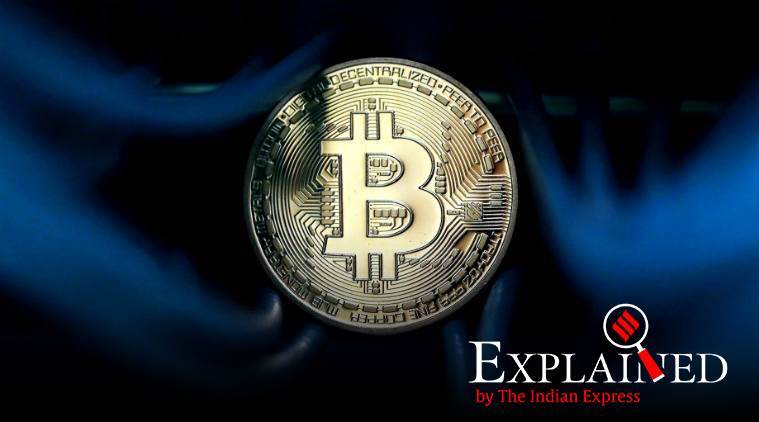
An inter-ministerial committee (IMC) that was set up to assess the viability of virtual currencies has recommended that India should ban private cryptocurrencies such as Bitcoin. The detailed report of the IMC was submitted on February 28 but it was made public only on July 23. It is available on the Department of Economic Affairs’ website.
What are virtual currencies?
A virtual currency is a digital representation of value that can be digitally traded and functions as (a) a medium of exchange, and/ or (b) a unit of account, and/or (c) a store of value, but, unlike fiat currency like the rupee, it is not legal tender and does not have the backing of a government. A cryptocurrency is a subset of virtual currencies, and is decentralised, and protected by cryptography.
What are Distributed Ledger Technologies and Blockchain?
Imagine a small group of school friends maintaining a list of transactions among themselves, but with a twist: Instead of holding this list in one single computer or in the notebook of one of the group members or authorising some outside authority (say, their class teacher) to maintain (and update) the list, all of them decide to maintain a separate copy of the list in their personal computers. Every time they transact, the rest of the members verify the transaction and once it is verified by all, they update their list. Further, to make sure that none of them changes records of the past transactions in their personal list, they decide to place each transaction as a block, and to stack it one after the other in a sequence. This way, no one can tweak the details of any past transactions because the overall sequence will not match with sequences held by others. Lastly, to make sure that no other child from the school gets to know the details, they devise a code (a cypher) for all their communications related to the list.

Broadly speaking, this is how Distributed Ledger Technologies, and Blockchain, in particular, function. DLT refers to technologies that involve the use of independent computers (also referred to as nodes) to record, share, and synchronise transactions in their respective electronic ledgers. Keeping such distributed ledgers obviates the need for keeping the data centralised, as is done in a traditional ledger. All virtual currencies use DLT.
A transaction under DLT essentially refers to the transfer of “value” from one to another. This “value” could be any record of ownership of assets — money, security, land titles — or the record of specific information such as information about one’s identity or health information, etc. That is why DLT has applications in several fields.
Blockchain is a specific kind of DLT that came to prominence after Bitcoin, a cryptocurrency that used it, became popular. Cryptocurrencies such as Bitcoin use codes to encrypt transactions and stack them up in blocks, creating Blockchains. It is the use of codes that differentiates cryptocurrencies from other virtual currencies.
What is the IMC’s view on DLT and cryptocurrencies?
The first thing to understand is that the IMC recognises the potential of DLT and Blockchain. The IMC accepts that internationally, the application of DLT is being explored in the areas of trade finance, mortgage loan applications, digital identity management or KYC requirements, cross-border fund transfers and clearing and settlement systems. To that extent, it recommends the Department of Economic Affairs (within the Finance Ministry) to take necessary measures to facilitate the use of DLT in the entire financial field after identifying its uses. The IMC also recommends that regulators — RBI, SEBI, IRDA, PFRDA, and IBBI — explore evolving appropriate regulations for development of DLT in their respective areas.
However, the IMC has recommended a ban on “private” cryptocurrencies. In other words, it is open to a cryptocurrency that the RBI may unveil. The IMC’s view is that it “would be advisable to have an open mind regarding the introduction of an official digital currency in India”. It noted that the RBI Act has the enabling provisions to permit the central government to approve a “Central Bank Digital Currency” (CBDC) as legal tender in India.
Why have private cryptocurrencies attracted a ban?
While it is true that the technology used in virtual currencies has immense potential, without a central regulating authority, they can have numerous downsides. The IMC’s first concern is that non-official virtual currencies can be used to defraud consumers, particularly unsophisticated consumers or investors. The IMC gives the example of the Rs 2,000 crore scam involving GainBitcoin in India where investors were duped by a Ponzi scheme. Moreover, such currencies often experience tremendous volatility in their value. For example, Bitcoin was selling at $20,000 per coin in December 2017 but in less than a year, it was trading at $3,800 per coin. In a country where lakhs of traders get involved in such currencies, this could have huge implications.
Second, scaling up such a currency system over a large population would require crippling levels of energy resources. Currencies such as Bitcoin require humongous processing power. According to a report by the Bank of International Settlement, Bitcoin processing already uses as much energy as is used by Switzerland; it called this an environmental disaster.
Third, the IMC is worried that if private cryptocurrencies are allowed to function as legal tender, the RBI would lose control over the monetary policy and financial stability, as it would not be able to keep a tab on the money supply in the economy.
Fourth, the anonymity of private digital currencies make them vulnerable to money laundering and use in terrorist financing activities while making law enforcement difficult.
Fifth, there is no grievance redressal mechanism in such a system, as all transactions are irreversible.
It is for these broad reasons that the IMC singled out private cryptocurrencies for a ban.








Gloss